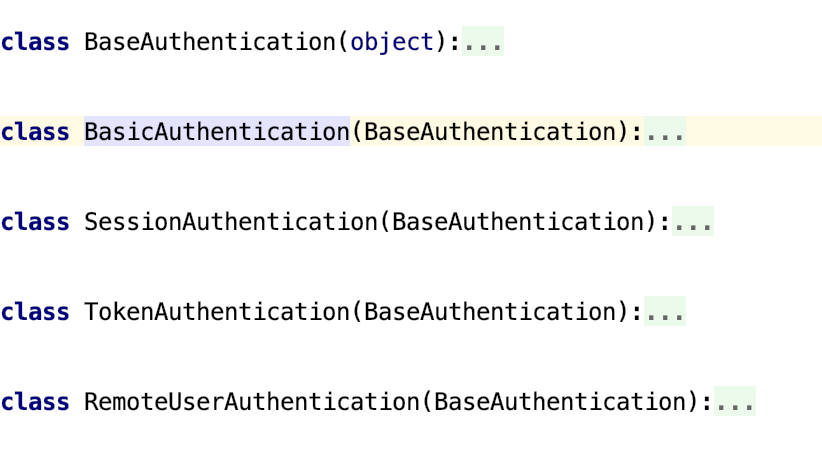一:基本知识
1:该三个组件阅读源码的方式和版本源码阅读步骤类似。详细阅读版本源码https://www.cnblogs.com/yingjp/p/10606698.html
2:进入initial可以看到以下方法
#认证执行的方法
self.perform_authentication(request)
#权限执行的方法
self.check_permissions(request)
#频率执行的方法
self.check_throttles(request)
3:进一步对上述的方法进行阅读我们能得出以下几点。
a:在settings中应该怎样配置
b:自定义组件需要实现什么方法
c:方法的返回值
d:对应的属性取值的方法
4:对认证,权限,频率这三个逐渐学习步骤
a:用rest_framework给我们提供的模块进行定制
b:自己定义组件
二:认证组件
1:阅读源码结论
a:认证类需要继承BaseAuthentication类
b:需要实现authenticate(self, request)方法
c:返回一个长度为2的元祖。
d:settings可以通过'DEFAULT_AUTHENTICATION_CLASSES'配置全局的验证。
2:自定义认证类(配置全局认证)
a;先写一个认证类
from rest_framework.authentication import BaseAuthentication
from testDemo.models import UserInfo
from rest_framework.exceptions import AuthenticationFailed
'''
这里是写的token是存在url中
1:需要继承BaseAuthentication
2:需要重写authenticate()方法
3:返回一个元祖
'''
class MyAuth(BaseAuthentication):
#自定义token在url中
def authenticate(self, request):
token = request.query_params.get('token','')
user=UserInfo.objects.filter(token=token).first()
if not user:
raise AuthenticationFailed('token 信息不合理')
return (user,token)
b:settings注册
--所有的视图函数都会进行认证,其实还不是很必要。局部认证在下面写
REST_FRAMEWORK={
#认证注册
'DEFAULT_AUTHENTICATION_CLASSES':['utils.auth.MyAuth',],
}
3:使用rest_framework提供的认证组件进行认证。
说明:认证组件一般都是自己写的,这里介绍自定义组件只是了解,学习视图函数的局部认证。
a:通过BaseAuthentication这个认证的基类,点进去就能看见所有人认证类了。使用方式和自定义的认证类一样

b:局部视图的认证,在需要认证的视图处添加authentication_classes=[authclass1,authclass2]
from utils.auth import MyAuth
# Create your views here.
from rest_framework.views import APIView,Response
import uuid
from testDemo.models import UserInfo
# Create your models here.
class authDemo(APIView):
authentication_classes = [MyAuth, ]
def get(self, request):
print(request.user)
print(request.auth)
return Response('测试代码')
三:权限组件
1:阅读代码结论
1:settings全局配置 key'DEFAULT_PERMISSION_CLASSES'
2:视图函数局部配置参数 permission_classes
3:权限类需要继承的类 from rest_framework.permissions import BasePermission
4:需要重写的方法 has_permission(self, request, view):
2:自定义权限类
from rest_framework.permissions import BasePermission
class MyPermissions(BasePermission):
def has_permission(self, request, view):
#登陆成功后登陆信息,存在request.user中
user_obj =request.user
#type ==3 普通用户 没有该权限
if user_obj.type ==3:
return False
return True
3:权限配置:
参考第一条。略
四:频率组件
说明:为了防止恶意访问,需要对同一个访问者进行访问频率控制,来减少服务器压力。
1:频率组件实现原理
DRF频率控制是通过单位时间内访问的次数来实现。在DRF的内部有一个字典,当一个iP访问的时候,如果IP1是已经访问的ip则在记录字典中添加这次的访问时间。
{'ip1':[时间1,时间2,最新时间]}。如果IP2是第一次访问,则该字典进行添加操作{'ip2':[最新访问时间]}
2:源码阅读结论(略)
--小结会总结源码快捷阅读技巧。
3:自定义频率控制类
from rest_framework.throttling import BaseThrottle
import time
VISIT_RECORD = {}
class MyThrotting(BaseThrottle):
def __init__(self):
self.history=[]
#方法实现
def allow_request(self, request, view):
"""
以IP限流 一分钟同一个IP只能访问五次
"""
#1:获取发访问一个ip
ip = request.META.get("REMOTE_ADDR")
'''
2:判断当前ip是否存在,如果存在,添加最新的时间,如果不存在添加新的ip
'''
now_time=time.time()
if ip in VISIT_RECORD:
VISIT_RECORD[ip].insert(0,now_time)
else:
VISIT_RECORD[ip]=[now_time]
history=VISIT_RECORD[ip]
'''
3:最后访问的和最新访问的时间相差一秒,删除最早访问的记录。保证字典内的记录均在一分钟以内。
'''
while history and history[0]-history[-1]>60:
history.pop()
self.history=history
"""
4:判断一分钟内,该ip访问次数是不是5次
"""
if len(history) > 5:
return False
else:
return True
def wait(self):
"""
需要等待多长时间,才能再次访问
"""
time = 60 - (self.history[0] - self.history[-1])
return time
4:局部配置和全局配置
--略
4:框架提供的频率认证组件的使用
1:导入包
--from rest_framework.throttling import SimpleRateThrottle
2:settings配置
--其他一些符号代表的时间频率
--('s', 'sec', 'm', 'min', 'h', 'hour', 'd', 'day')
REST_FRAMEWORK = {
"DEFAULT_THROTTLE_RATES":{
'WD':'5/m', #速率配置每分钟不能超过5次访问,WD是scope定义的值,
}
}
3:类的编写
from rest_framework.throttling import BaseThrottle,SimpleRateThrottle
class MyVisitThrottle(SimpleRateThrottle):
#与settings配置的一样
scope = "WD"
def get_cache_key(self, request, view):
return self.get_ident(request)
4:局部使用
class authDemo(APIView):
throttle_classes=[MyVisitThrottle]
def get(self, request):
return Response('测试代码')
五:小结
1:源码快速阅读总结
a:观察框架实现的组件,可以发现导入规律
-- rest_framework.组件英文拼写 import Base英文拼写
from rest_framework.throttling import BaseThrottle from rest_framework.authentication import BaseAuthentication from rest_framework.permissions import BasePermission
b:点进对应的方法,下面均有不同的实现,但是可以看到需要重写什么方法。这样就能自定义组件了
2:组件阅读源码快速配置
a:setings一定配置 REST_FRAMEWORK={}
一定要写
REST_FRAMEWORK = {}
a:进入视图继承类APIView
--中文注释我自己写的,是不是正好可以得出中文注释结论
--全局配置key是 = 后面的值,
--局部配置在 = 前面的参数
renderer_classes = api_settings.DEFAULT_RENDERER_CLASSES
parser_classes = api_settings.DEFAULT_PARSER_CLASSES
'''
权限认证
'''
authentication_classes = api_settings.DEFAULT_AUTHENTICATION_CLASSES
'''
频率认证
'''
throttle_classes = api_settings.DEFAULT_THROTTLE_CLASSES
'''
权限认证
'''
permission_classes = api_settings.DEFAULT_PERMISSION_CLASSES
content_negotiation_class = api_settings.DEFAULT_CONTENT_NEGOTIATION_CLASS
metadata_class = api_settings.DEFAULT_METADATA_CLASS
'''
版本认证
'''
versioning_class = api_settings.DEFAULT_VERSIONING_CLASS